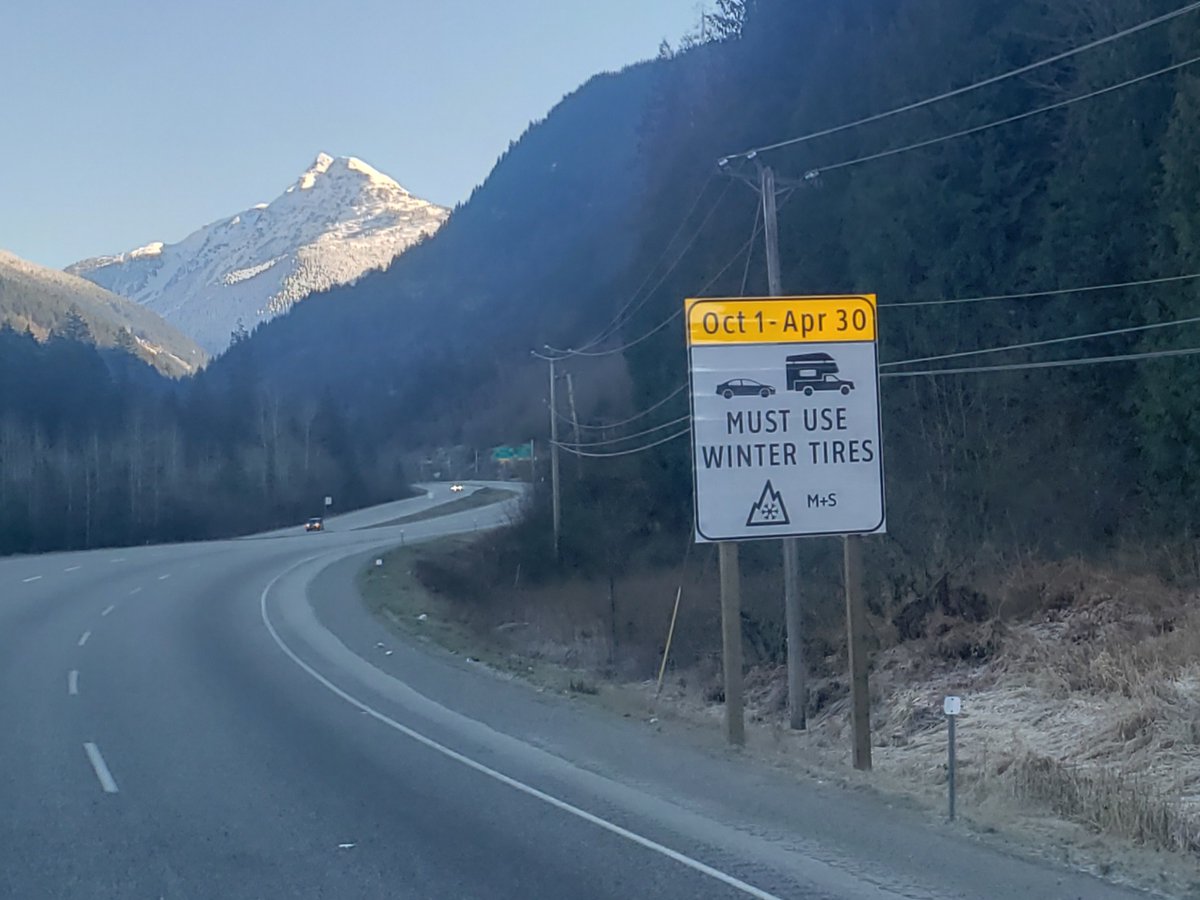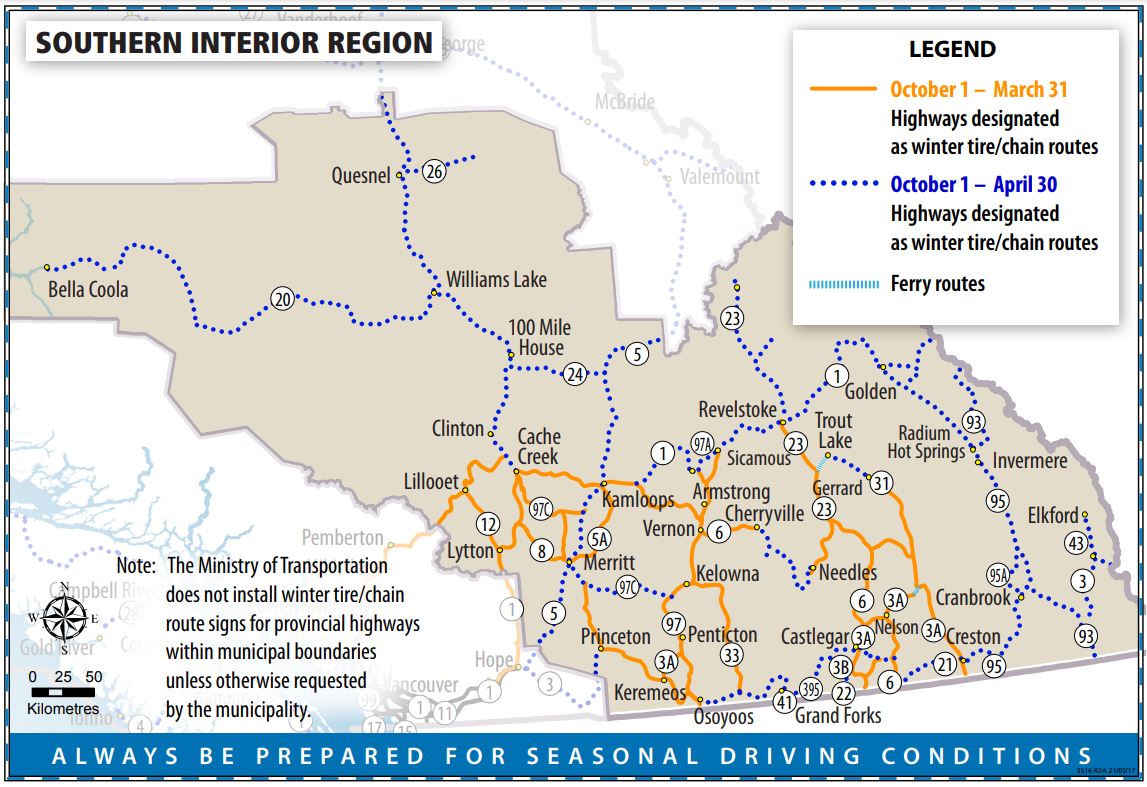
Much like naively donning shorts and a t-shirt at the slightest sign of spring, the temptation to swap out winter tires can be strong. But be careful: the consequences of prematurely exposing Vitamin-D deprived skin with fewer threads pales in comparison to facing severe winter weather with unsuitable summer treads.
Let’s face it, Old Man Winter doesn’t care what our calendar claims. He’s been known to revel in pranking people travelling through mountain passes on April 1 (yes, April Fools’ Day), the day winter tire and commercial chain requirements ended in years past.
Not this year.
Since 2019, mandatory winter tire and chain requirements extend to April 30 on select highways, including mountain passes and rural routes in high snowfall areas.
Which routes, exactly? Well, we’ve got four handy maps for that, one for each region. Here’s the Southern Interior. Collect them all by visiting our Designated Winter Tire & Chain-up Routes webpage.

So, the question remains: to swap or not to swap? Tires, that is.
In this case, the blue dotted line means there’s a chance the white stuff could fall here through April. You’ll notice northern BC and high elevation mountain passes are coloured accordingly.
On the other hand, if you tend to stick to highways marked in orange, there is less of a chance of running into snow after March 31. But anything can happen. These are only guidelines – Old Man Winter doesn’t listen to us. Fortunately, you can check road conditions via the DriveBC website before heading out.
Remember: a legal winter tire is defined as one with at least 3.5mm of tread and either the mountain/snowflake and/or M+S marked on the sidewall. However, it’s important to note the differences between these two tires.
Severe winter tires with the mountain/snowflake emblem maintain good traction in winter conditions because they are composed of a rubber compound that stays soft in cold temperatures. They also have an aggressive tread design for added traction on snow and ice.
Meanwhile, M+S tires may not perform as well as severe winter tires in harsh conditions; however, they have a shape and tread design that gives better traction than summer tires in snow and ice.
Therefore, some people choose to use mountain/snowflake tires in the winter, and M+S tires the rest of the year.
When it comes to commercial vehicle drivers, we know many choose to keep chains onboard year-round. Because, why not? Good idea to be prepared at any time, in any situation.
Now that you’re informed about the extended winter tire and chain regulations, it’s up to you to decide whether it’ll be the right time for shorts, t-shirt, and a tire swap come April. What will it be? Let us know in the comment section.
Hi. I’m in Newfoundland. What is the deadline for studded tire removal.
Hello, thanks for your message.
We can’t speak for studded tire regulations for Newfoundland as we are only responsible for transportation in the Province of British Columbia. We encourage you to check with the Government of Newfoundland and Labrador directly:
https://www.gov.nl.ca/
Looking for clarification on when studded tires must be removed. The regular period for studded/winter tires ends March 31 and then it indicates studs are not allowed past April 30. Has the rule been adjusted now that the winter tire requirement has been extended to April 30 for some routes, ie: is there a grace period after April 30 to allow for the studded tires to be removed? Thanks
Hi Brian. The timeline for studded tires has not changed – they may only be used on BC highways between October 1 and April 30. This helps protect highway infrastructure. However, it would be up to law enforcement to determine whether a fine is warranted based on circumstances.
Hi. I know that I’m not required to drive with winter tires in May, but I’ll be driving from Winnipeg to White Rock, leaving on May 3, and I have, now, an appointment for a car tune-up and to get the winter tires off.
Do you think I should leave the winter tires on until the end of May, when I return to Winnipeg?
Hi Tannis,
You should be fine having your winter tires removed in May, before you travel from Winnipeg to White Rock.
Driving winter tires marked with the “mountain and snowflake symbol” on bare pavement wears them out faster, because the compound is softer. More about that: https://www.tranbc.ca/2014/10/24/how-to-choose-from-4-types-of-winter-tires-for-winter-driving-in-bc/
Some people (who don’t live in places with regular snow and ice conditions during winter) drive all-year-round with M+S tires, which are also considered winter tires: https://www.youtube.com/watch?v=9x4Zob9J2mE&list=PLKHNpQ_j-IWE0JwRTfm1rPDQQd0tSsZP3&index=5
I recommend you check DriveBC.ca during your journey through BC, so you can know what’s ahead. Use the map to find out the conditions, and see the webcams views for your route. If the Coquihalla Hwy is having a spring snow storm, and you don’t have M+S or other winter tires, you can travel via Hwy 1, from Cache Creek to Hope. Some short tutorials to help you get acquainted with this useful tool: https://www.youtube.com/watch?v=px7Z61ec1JE&list=PLKHNpQ_j-IWF-0iOSp4PCE5Ky7picvgLz
Safe journey!
Pretty frustrating that highway 1 from Kamloops east to highway 97 turnoff is green yet highway 97 is orange. Extra frustrating that people living within Kamloops city limits who travel on highway 1 will have to run winters in a month with high temps reaching 25. That temperature will destroy a good winter tire quickly.
Thanks for your feedback John, we’ve sent your concern to the local area manager for review. We will let you know what we hear back.
Hello John,
We connected with the local area manager who confirmed that the passenger car requirement to use winter tires is based on the signs installed on our highways (as found on BC Highway 1 eastbound to the junction with 97). As you travel in the Kamloops area, you will see those signs near the limits of the city, as you set out onto our rural highway. Having said that, it is typical at this time of year for temperatures in Kamloops to drop below 7 degrees Celsius, which is the temperature at which all-season tires begin to lose their grip. Today for example there was snow on BC Highway 5 and other high elevation stretches as well.
Travelling to Victoria from port alberni near mid April, do I need winter tires
Hello Jayne,
No, winter tires will not be required between Port Alberni and Tofino after March 31.
https://www2.gov.bc.ca/assets/gov/driving-and-transportation/driving/winter/pdfs/southcoastmap.pdf
There is currently construction at Kennedy Hill and there may be construction delays. Please check DriveBC.ca for traveller information and the Kennedy Hill project page for any anticipated construction delays: https://www2.gov.bc.ca/gov/content/transportation/transportation-infrastructure/projects/highway4kennedyhill/traffic-advisories
Driving from Vancouver to Hope on April 5th. Can I take my winter tires off & go with all-seasons?
Hi Katherine,
Yes, you can use your all season tires after March 31 between Vancouver and Hope. Here’s a map identifying where winter tires are required and when: https://www2.gov.bc.ca/assets/gov/driving-and-transportation/driving/winter/pdfs/southcoastmap.pdf
Is it possible to get a better (larger) map in the West Kootenay area? The highway number dots on the map completely cover Trail and Rossland, and it’s not clear where the actual demarcations are between the March 31 and April 30 sections. Given there are no “April 30” signs posted in our area yet, it would seem unfair to convict someone on the basis of the map alone.
Hi Paul – we are working on getting you this information, at this time it might just be a list, not a map. Stay tuned.
I am planning on driving from Calgary to Vancouver first week of April.
Will all season tires be okay?
Hi Michelle. All-season tires with the M+S symbol on the sidewall, and with at least 3.5 mm of tread, are considered legal winter tires on all BC highways. We do, however, recommend winter tires with the mountain/snowflake symbol on the sidewall for severe winter conditions, which can still exist along high spring snowfall areas, such as mountain passes, through April.
Check http://www.drivebc.ca before you go in order to see road conditions along your route. Safe Travels!
I am planning to travel from Coquitlam to Manning Park? Is it ok with all season tire? Thanks
HI Tian Yu,
In BC, winter tires fall into three main categories, which are all-season, all-weather and the three-peaked mountain/snowflake snow traction tires. (So you can legally drive with the tires you have on your vehicle now).
Currently, the road looks bare along your route, but we suggest you check this webcam before you go: http://images.drivebc.ca/bchighwaycam/pub/html/www/65.html Also, check DriveBC.ca for any current information, as weather can change quickly at high elevations.
Safe journey!
Hwy 3 may be in green but the signs say March 31. I still go April 30
Yes, thanks Irena. Signs will be installed as soon as they are ready.